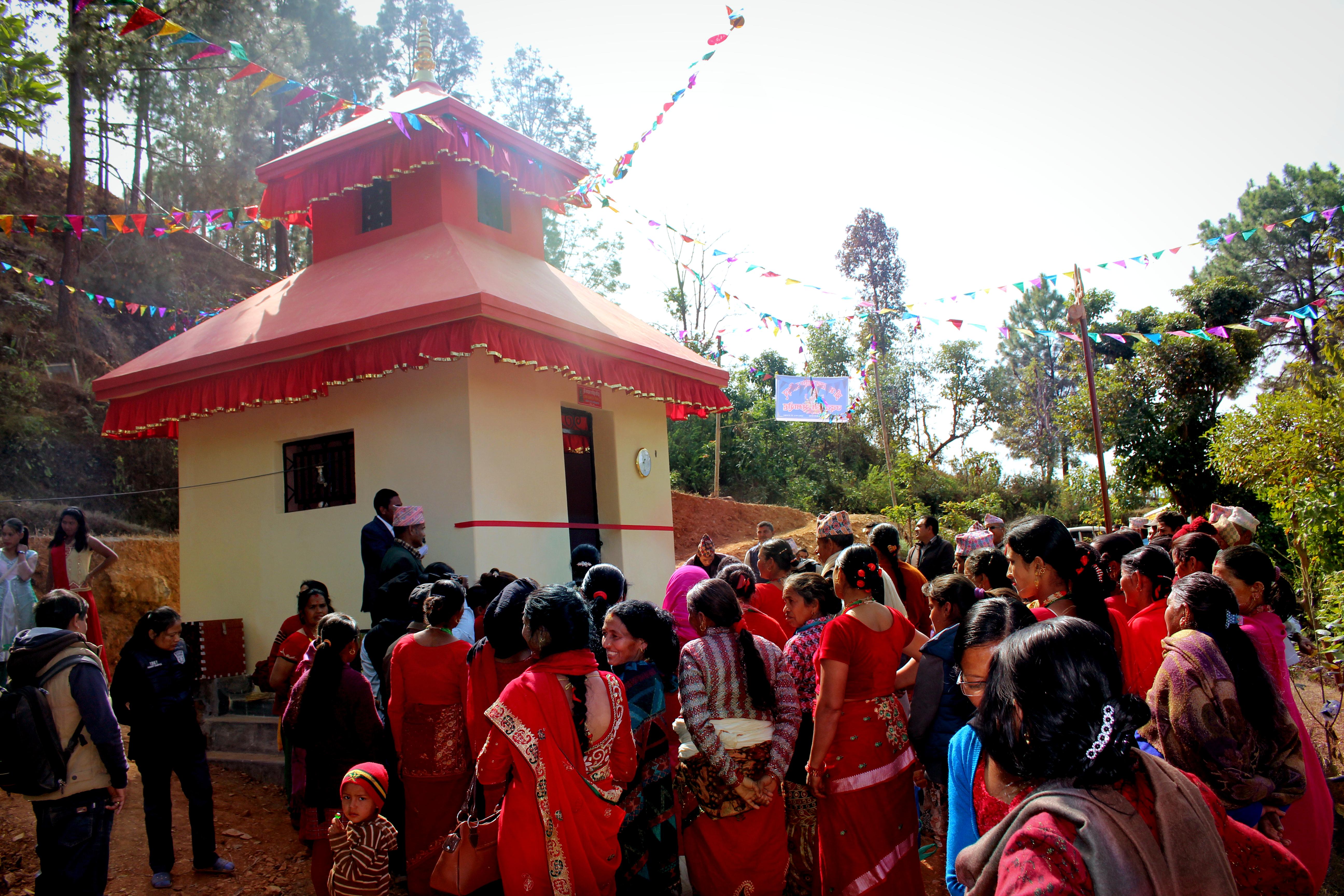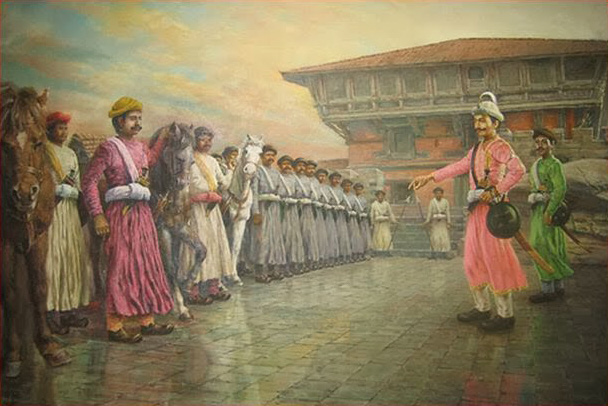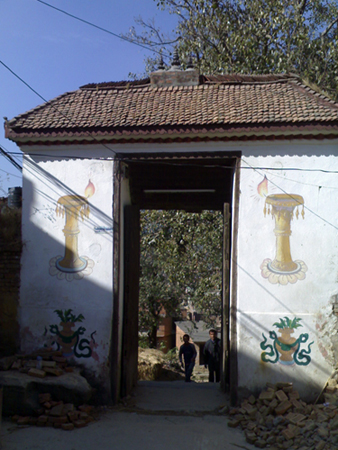|
Birabhadra Thapa
Bir Bhadra Thapa or Birabhadra Thapa ( ne, वीरभद्र थापा) also spelled Virabhadra or Virbhadra, was a politician, courtier and military officer in the Gorkha Kingdom during the 18th century. Born in medieval Tanahun Kingdom, he left his ancestral property there and migrated into the uprising Gorkha Kingdom. He got entry into the minor ranks of military of King Prithvi Narayan Shah due to being a nephew of Sura Prabha, the wife of military commander Shivaram Singh Basnyat of the Basnyat dynasty. Thereafter, he took part in the various battles of Unification of Nepal throughout his life. Among his grandsons, Bhimsen Thapa went on to become the Mukhtiyar of Nepal (equivalent to Prime Minister) for 31 years and founder of Thapa dynasty. Family Birbhadra belonged to the prominent Bagale Thapa clan of Jumla that migrated eastwards as per Gorkha chronicles. The ''Thapa genealogy'' states that Birbhadra was a grandson of Bikram Thāpā and son of Bijay (Bijai) Thāp ... [...More Info...] [...Related Items...] OR: [Wikipedia] [Google] [Baidu] |
Kaji (Nepal)
''Kaji'' ( ne, काजी) was a title and position used by nobility of Gorkha Kingdom (1559–1768) and Kingdom of Nepal between 1768 and 1846. Many other contemporary kingdoms used the same title for their ministers. Etymology Historian Mahesh Chandra Regmi suggests that ''Kaji'' is derived from Sanskrit word ''Karyi'' which meant functionary. History Ganesh Pande was the first Kaji under King Dravya Shah of Gorkha Kingdom. He helped Dravya Shah to become King of Gorkha and was later appointed Kaji of Gorkha in 1559 A.D. Another significant Kaji of Gorkha was Kalu Pande born in the family of Ganesh Pande. He was son of Bhimraj Pande who was also a Kaji during the reign of King Nara Bhupal Shah. Kalu Pande led Gorkhalis in the Battle of Kirtipur. He had set up a base on Naikap, a hill on the valley's western rim, from where they were to mount their assaults on Kirtipur. He was killed in the battle after being surrounded by enemy forces. The ministers and officials of Kantipur ... [...More Info...] [...Related Items...] OR: [Wikipedia] [Google] [Baidu] |
Bagale Thapa
Bagale Thapa ( ne, बगाले थापा pronunciation:) anciently known as Bagalya Thapa ( ne, बगाल्या थापा) is a prominent clan within Thapa of Khas community. They claim Atreya Gotra. The name of the clan is also transliterated as ''Bagale'', ''Bagalya'', ''Bagaalya'', ''Bagaliya'', ''Bagaley'', ''Bagaale'' or ''Bagaleya''. Family of Bhimsen Thapa and family of Amar Singh Thapa were two influential Bagale Thapa families at the central politics of Kingdom of Nepal. Origins Bagale Thapa genealogy The genealogy traces the lineage of all Bagale Thapas to a male progenitor (''Mūlapuruṣa'') Kalu Thapa Kshatri. The genealogy states that Kalu Thapa had four sons; Punyakar of Pulaam state, Tarapati of Takam state, Biru and Dharmaraj (Jashodhar) of Jamarik state. The genealogy describes that Kaalu adhered to the following sects: " Aatreya gotri Tripravara, Shukla Yajurveda, Dhanurveda and Madhyandini Shakha". Kunwar family legend Kunwar fam ... [...More Info...] [...Related Items...] OR: [Wikipedia] [Google] [Baidu] |
Kavrepalanchok District
Kavrepalanchok District ( ne, काभ्रेपलाञ्चोक जिल्ला; ) is one of the 77 districts of Nepal. The district, with Dhulikhel as its district headquarters, covers an area of . It is a part of Bagmati Province and has a population of 381,937. Information Technology Park is also located in this district. Geography and climate Demographics At the time of the 2011 Nepal census, Kavrepalanchok District had a population of 381,937. Of these, 50.9% spoke Nepali, 33.5% Tamang, 11.1% Newari, 1.6% Danuwar and 1.4% Magar as their first language. 42.8% of the population in the district spoke Nepali, 0.8% English and 0.6% Tamang as their second language. Administration The district consists of 13 Municipalities, out of which six are urban municipalities and seven are rural municipalities. These are as follows: *Dhulikhel Municipality *Banepa Municipality * Panauti Municipality * Panchkhal Municipality * Namobuddha Municipality * Mandandeupu ... [...More Info...] [...Related Items...] OR: [Wikipedia] [Google] [Baidu] |
Sankhu
Sankhu (साखु) (alternative name: Sakwa (Nepal Bhasa: सक्व)) is the ancient Newar town located in the north-eastern corner of Kathmandu Valley which is about 17 km from the city center of Kathmandu. Sankhu was formerly divided into three Village Development Committee, namely, Pukhulachhi, Suntol and Bajrayogini. Recently the town of Sankhu has been declared as Shankharapur Municipality merging three above-mentioned VDCs and other neighbouring VDCs. At the time of the 2011 Nepal census it had a population of 4333 living in 928 individual households. Sankhu lies between river Salinakhu (also Salinadi) in east and Asakhu in the west. It is believed that the name ''Sakwa'' has two parts- Kvay (Meaning Tibet) and Samde (Meaning Below), in total it means a town below Tibet. Sankhu is also known as Shankharapur for its famous ancient Sankha-shaped town structure. This place is also known as the Eighty Siddhas, because there are four of five caves where the siddhas ... [...More Info...] [...Related Items...] OR: [Wikipedia] [Google] [Baidu] |
Panauti
Panauti ( ne, पनौती) is a municipality in Kavrepalanchok District in Bagmati Province of Nepal located 32 km Southeast of the capital Kathmandu. The town is currently listed as a UNESCO tentative site since 1996. Origin Panauti is a historical city in Nepal, originally it was a small state given by King Bhupatindra Malla as a dowry to his sister. This town has a population of under 15,000 people and a few prominent icons, such as the Indreswor temple and Panauti (Layaku) Durbar square found in the town center. At the end of the 0th Century, Panauti was finally integrated into the unified kingdom of Nepal, along with Kathmandu, Patan, and Bhaktapur, which are all former capital cities of the Kathmandu valley. Panauti was a trading hub along the ancient Salt Trade route between Tibet and India. Actually, the recorded history of Panauti goes back to the first century AD. However, with the end of the Salt trade in the 1950s and the construction of the Arniko Highway ... [...More Info...] [...Related Items...] OR: [Wikipedia] [Google] [Baidu] |
Nuwakot District
Nuwakot District ( ne, नुवाकोट जिल्ला, a part of Bagmati Province, is one of the seventy-seven districts of Nepal. The district, with Bidur as its district headquarters, covers an area of and had a population of 288,478 in 2001 and 277,471 in 2011. It is a historically important district in Nepal. Prithvi Narayan Shah died in Devighat of Nuwakot. The district contains places of historical significance such as the town of Nuwakot, and the village of Devighat located at the confluence of the Tadi and Trishuli Rivers. Kakani is popular among Nepalese people as a touristic place and picnic spot. Nuwakot holds the different reminance from the unification movement pioneered by late king Prithvi Narayan Shah to the present situation. Etymology The name, 'Nuwakot', is made up of two words 'nawa' and 'kort'. 'Nawa' means nine in Nepali and 'kort' means sacred religious sites at the top of hill. The district accordingly has nine hills over which various deitie ... [...More Info...] [...Related Items...] OR: [Wikipedia] [Google] [Baidu] |
Jamadar
Jemadar or jamadar is a title used for various military and other officials in the Indian subcontinent. Etymology The word stems from Urdu (), which derives through Persian ''jam'dar'' from Arabic ''jamā‘a(t)'' 'muster' + Persian ''-dār'' 'holder'. Pre-colonial A jemadar was originally an armed official of a zamindar (feudal lord) in India who, like a military general, and along with Mridhas, was in charge of fighting and conducting warfare, mostly against the rebellious peasants and common people who lived on the lord's land. Also, this rank was used among the thuggees as well, usually the gang leader. Later, it became a rank used in the British Indian Army, where it was the lowest rank for a Viceroy's commissioned officer. Jemadars either commanded platoons or troops themselves or assisted their British commander. They also filled regimental positions such as assistant quartermaster (jemadar quartermaster) or assistant adjutant (jemadar adjutant). Post-colonial Th ... [...More Info...] [...Related Items...] OR: [Wikipedia] [Google] [Baidu] |
Unification Of Nepal
The Unification of Nepal, also known as Expansion of Gorkha Kingdom, officially began in 1743 AD (1799 BS) after King Prithvi Narayan Shah of Gorkha launched an aggressive annexation campaign seeking to broaden his own kingdom's border. After conquering the Nepal Mandala, which consisted of the different city-states of the Kathmandu, Lalitpur, Kirtipur and Bhaktapur, Shah moved his hilly capital in Gorkha to the fertile and wealthy city of Kathmandu and adopted the name Nepal for the entire Gorkha Empire. The Shah dynasty would go on to expand the various warring kingdoms that once occupied parts of present-day Nepal into a nation-state that stretched up to the Sutlej River in the west and Sikkim-Jalpaiguri in the east. Before usage by the Gorkha Empire, the Kathmandu Valley was known as Nepal after the Nepal Mandala, the region's Nepal Bhasa name. Invasion of Nuwakot Prithvi Narayan Shah's annexation campaign began with the nearby kingdom of Nuwakot. Nuwakot marked the eas ... [...More Info...] [...Related Items...] OR: [Wikipedia] [Google] [Baidu] |
Kalu Pande
Vamshidhar Pande ( ne, वंशीधर पाँडे) known by Alias Kalu Pande ( ne, कालु पाँडे) was a Nepalese politician and military general who was appointed as Kaji of The Gorkha Kingdom. He was born in 1713 A.D. in Gorkha. He was the commander of the Gorkhali forces during the Unification Campaign of Nepal who died in the first Battle of Kirtipur in 1757 A.D. Pande's real name was Banshidhar Pande. He was a son of ''Kaji'' Bhimraj Pande who was minister during reign of King Prithivipati Shah of Gorkha. He was descendant of Minister of Gorkha and Dravya Shah's accomplice Ganesh Pande. He had three sons: ''Dewan Kajisaheb'' Vamsharaj Pande, Sardar Ranasur Pande and ''Mulkaji Sahib'' Damodar Pande (1st PM of Nepal). Family Pande was born in 1713 A.D to ''Kaji Bhimraj Pande''. He was a descendant of Ganesh Pande, who was the first Kaji (Prime Minister) of King Dravya Shah of Gorkha Kingdom established in 1559 A.D. The Pandes were considered as Thar ... [...More Info...] [...Related Items...] OR: [Wikipedia] [Google] [Baidu] |
Battle Of Kantipur
The Battle of Kathmandu ( ne, काठमाडौंको युद्ध) or Siege of Kathmandu or Siege of Kantipur is a battle which occurred during the Unification of Nepal. It was fought in Kathmandu in 1768, and resulted in the defeat of its king Jaya Prakash Malla by conquerors Prithvi Narayan Shah, king of the adjoining Gorkha Kingdom. Shah's victory marked the establishment of the Shah dynasty in Nepal and the end of the rule of the indigenous Newars. The Newars, lost to the Gorkhalis who were expanding their kingdom. The blockade Kathmandu (alternative names: Yen Desa येँ देस, Kantipur) was one of the three capital cities in the Kathmandu Valley, the other two being Lalitpur and Bhaktapur. The kingdom of Kathmandu extended to a distance of 12–13 days journey north to the Tibetan border. The Trishuli River marked the boundary between Kathmandu and Gorkha in the west. The Gorkhalis desired the Kathmandu Valley due to its rich culture, trade, industry ... [...More Info...] [...Related Items...] OR: [Wikipedia] [Google] [Baidu] |
Chhetri
Chhetri (Kshetri, Kshettri, Kshetry or Chhettri), ( ne, क्षेत्री ; IAST: ''Kṣetrī'') historically called Kshettriya or Kshetriya or Khas are Nepali speakers of Khas community, some of whom trace their origin to migration from medieval India. Chhetri was a caste of administrators, governor and military elites in the medieval Khas Kingdom and Gorkha Kingdom (later unified Kingdom of Nepal). The nobility of the Gorkha Kingdom mainly originated from Chhetri families. They also had a strong presence in civil administration affairs. The bulk of prime ministers of Nepal before the democratization of Nepal belonged to this caste as a result of the old Gorkhali aristocracy. Gorkha-based aristocratic Chhetri families included the Pande dynasty, the Basnyat dynasty, the Kunwar family, and the Thapa dynasty, (Rana dynasty and other Kunwars). Khas Chhetris were traditionally considered a division of the Khas people with Khas Brahmin (commonly called Khas Bahun). They m ... [...More Info...] [...Related Items...] OR: [Wikipedia] [Google] [Baidu] |
Baburam Acharya
Baburam Acharya ( Nepali: बाबुराम आचार्य) (1888–1971 AD) was a Nepalese historian and literary scholar. He is known as the historian laureate () of Nepal. The four part biography of King Prithivi Narayan Shah, founder of Modern Nepal is a key series of work he created. He is known for the study of ancient Nepalese inscriptions. Sagarmatha Nepal’s eminent historian late Baburam Acharya is credited with the Nepali name Sagarmatha () for Mount Everest that straddles Nepal-China border. Previously, Nepal had no official name of its own for the world’s tallest peak in Nepali, although official name among many Nepalese people - Sherpa Sherpa may refer to: Ethnography * Sherpa people, an ethnic group in north eastern Nepal * Sherpa language Organizations and companies * Sherpa (association), a French network of jurists dedicated to promoting corporate social responsibility * ..., Limbu, etc. existed long ago. What may not be true however is that h ... [...More Info...] [...Related Items...] OR: [Wikipedia] [Google] [Baidu] |







